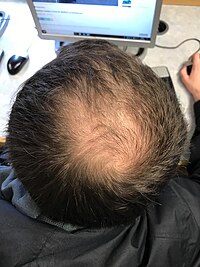
Photo from wikipedia
Simple Summary Pemphigus vulgaris is a potentially fatal disease characterised by blister formation affecting the skin and mouth. The mechanisms of blister formation may involve a biological process called apoptosis—a… Click to show full abstract
Simple Summary Pemphigus vulgaris is a potentially fatal disease characterised by blister formation affecting the skin and mouth. The mechanisms of blister formation may involve a biological process called apoptosis—a type of cell death—and some death-associated molecules known as caspases. Our review of the existing literature shows that caspase inhibitors exhibit an inhibitory effect on PV-induced apoptosis formation in vitro. In particular, activity of caspase 1 and caspase 3 is essential for the development of PV in vitro and in vivo. However, a majority of in vivo studies assessing caspase inhibition in PV models have a high risk of bias. Abstract Background: Pemphigus vulgaris (PV) is an IgG-mediated autoimmune disease characterised by epithelial cell–cell detachment (acantholysis) resulting in mucocutaneous blistering. The exact pathogenesis of blister formation is unknown and this has hampered the development of non-steroidal, mechanism-based treatments for this autoimmune disease. This systematic review aims to investigate the role of caspases in the pathogenesis of PV to inform the choice of more targeted therapeutic agents. Methods: A systematic search of MEDLINE/PubMed and Scopus databases was conducted to identify eligible studies. Multiple phases of inclusion and exclusion of the primary articles were conducted in pairs, and studies were recorded and analysed according to the latest version of the preferred reporting items for systematic reviews and meta-analyses (PRISMA). Risk of bias assessment was conducted for extracted in vivo animal intervention studies using SYRCLE’s risk of bias tool. Results: Eight articles from a total of 2338 in vitro, in vivo, and human studies met the inclusion criteria, with a high degree of inter-rater reliability. By and large, the results show that caspase activation was pathogenic in experimental PV because pan-caspase inhibitors could block or reduce PV acantholysis and blistering in vitro and in vivo, respectively. The pathogenic pathways identified involved caspase-1 and caspase-3. One study failed to show any improvement in the PV model with a caspase inhibitor. The majority of animal studies had high or unclear risk of bias. Conclusion: There are consistent data pointing towards a pathogenic role of caspase activation in PV acantholysis. However, high-quality evidence to confirm that caspase inhibition can prevent PV-induced blistering in vivo is limited. Therefore, further research is required to test the preclinical efficacy of caspase inhibitors in PV.
Journal Title: Biology
Year Published: 2022
Link to full text (if available)
Share on Social Media: Sign Up to like & get
recommendations!